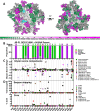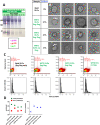Engineering well-expressed, V2-immunofocusing HIV-1 envelope glycoprotein membrane trimers for use in heterologous prime-boost vaccine regimens
- PMID: 34679128
- PMCID: PMC8565784
- DOI: 10.1371/journal.ppat.1009807
Engineering well-expressed, V2-immunofocusing HIV-1 envelope glycoprotein membrane trimers for use in heterologous prime-boost vaccine regimens
Abstract
HIV-1 vaccine immunofocusing strategies may be able to induce broadly-reactive neutralizing antibodies (NAbs). Here, we engineered a panel of diverse, membrane-resident native HIV-1 trimers vulnerable to two broad targets-the V2 apex and fusion peptide (FP). Selection criteria included i) high expression and ii) infectious function, so that trimer neutralization sensitivity can be profiled in pseudovirus (PV) assays. Initially, we boosted the expression of 17 candidate trimers by truncating gp41 and introducing a gp120-gp41 SOS disulfide to prevent gp120 shedding. "Repairs" were made to fill glycan holes and eliminate other strain-specific aberrations. A new neutralization assay allowed PV infection when our standard assay was insufficient. Trimers with exposed V3 loops, a target of non-NAbs, were discarded. To try to increase V2-sensitivity, we removed clashing glycans and modified the C-strand. Notably, a D167N mutation improved V2-sensitivity in several cases. Glycopeptide analysis of JR-FL trimers revealed near complete sequon occupation and that filling the N197 glycan hole was well-tolerated. In contrast, sequon optimization and inserting/removing glycans at other positions frequently had global "ripple" effects on glycan maturation and sequon occupation throughout the gp120 outer domain and gp41. V2 MAb CH01 selectively bound to trimers with small high mannose glycans near the base of the V1 loop, thereby avoiding clashes. Knocking in a rare N49 glycan was found to perturb gp41 glycans, increasing FP NAb sensitivity-and sometimes improving expression. Finally, a biophysical analysis of VLPs revealed that i) ~25% of particles bear Env spikes, ii) spontaneous particle budding is high and only increases 4-fold upon Gag transfection, and iii) Env+ particles express ~30-40 spikes. Taken together, we identified 7 diverse trimers with a range of sensitivities to two targets to allow rigorous testing of immunofocusing vaccine concepts.
Conflict of interest statement
The authors have declared that no competing interests exist.
Figures











References
-
- Crooks ET, Tong T, Chakrabarti B, Narayan K, Georgiev IS, Menis S, et al.. Vaccine-Elicited Tier 2 HIV-1 Neutralizing Antibodies Bind to Quaternary Epitopes Involving Glycan-Deficient Patches Proximal to the CD4 Binding Site. PLoS Pathog. 2015;11(5):e1004932. doi: 10.1371/journal.ppat.1004932 - DOI - PMC - PubMed
-
- Dubrovskaya V, Guenaga J, de Val N, Wilson R, Feng Y, Movsesyan A, et al.. Targeted N-glycan deletion at the receptor-binding site retains HIV Env NFL trimer integrity and accelerates the elicited antibody response. PLoS Pathog. 2017;13(9):e1006614. doi: 10.1371/journal.ppat.1006614 - DOI - PMC - PubMed
-
- Charles TP, Burton SL, Arunachalam PS, Cottrell CA, Sewall LM, Bollimpelli VS, et al.. The C3/465 glycan hole cluster in BG505 HIV-1 envelope is the major neutralizing target involved in preventing mucosal SHIV infection. PLoS Pathog. 2021;17(2):e1009257. doi: 10.1371/journal.ppat.1009257 - DOI - PMC - PubMed
Publication types
MeSH terms
Substances
Grants and funding
LinkOut - more resources
Full Text Sources
Molecular Biology Databases
Miscellaneous

